Global Digital Twin Market is estimated to be worth USD 9.8 Billion in 2022 and is projected to grow at a CAGR of 34.4% between 2023 to 2032. The study has considered the base year as 2022, which estimates the market size of market and the forecast period is 2023 to 2032. The report analyzes and forecasts the market size, in terms of value (USD Billion), for the market. The report segments the market and forecasts it by solution, by deployment, by enterprise, by application, by end user and region/country.
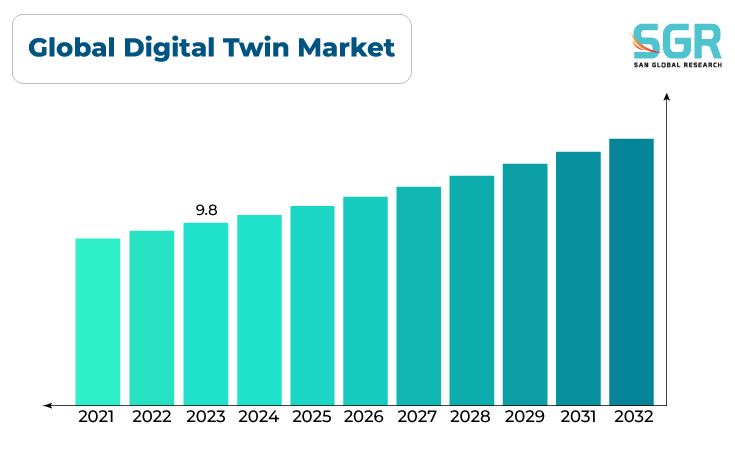
The global digital twin market represents an increasingly dynamic and innovative landscape at the intersection of technology and industry. Digital twin technology involves creating virtual replicas or models of physical assets, systems, or processes, enabling real-time simulations, monitoring, and analysis. This market has witnessed remarkable growth owing to its applications across various sectors such as manufacturing, healthcare, automotive, aerospace, and smart cities. Digital twins offer an invaluable advantage by providing insights into the performance, behavior, and predictive analytics of physical assets, enhancing operational efficiency, and facilitating data-driven decision-making. Industries utilize digital twins to optimize processes, simulate scenarios, predict maintenance needs, and streamline product development, resulting in reduced downtime, cost savings, and improved productivity. The adoption of IoT (Internet of Things) sensors, AI (Artificial Intelligence), and advanced analytics further strengthens the capabilities of digital twins, allowing for a more comprehensive understanding and management of complex systems. As industries increasingly recognize the potential for digital twins to drive innovation, improve performance, and enable proactive problem-solving, the global digital twin market continues to expand, poised for continual evolution and transformative impact across diverse sectors.
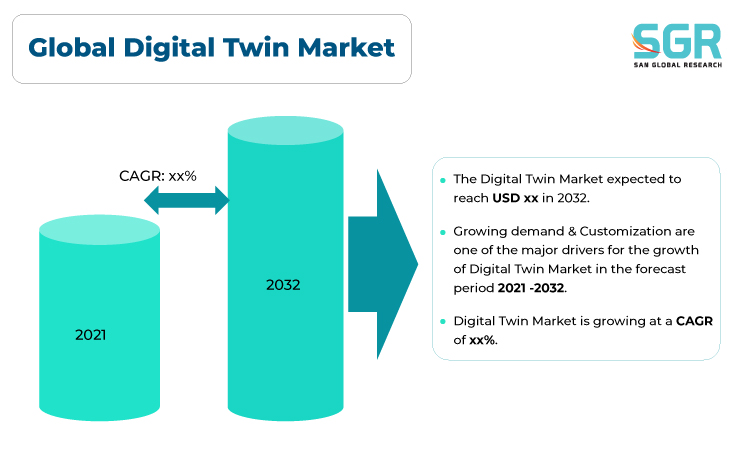
Region Wise Comparison:
North America, particularly the United States, led the digital twin market, driven by significant investments in technology and innovation. Industries like manufacturing, healthcare, and aerospace embraced digital twin technology for predictive maintenance, product development, and operational optimization. The region's advanced technological infrastructure and a robust ecosystem of tech companies contributed to its dominance in this market.
European countries, including the United Kingdom, Germany, and France, were actively adopting digital twin technology across industries such as manufacturing, automotive, and smart infrastructure. Europe's emphasis on Industry 4.0 initiatives and its strong manufacturing base fueled the adoption of digital twins for optimizing production processes and improving operational efficiency.
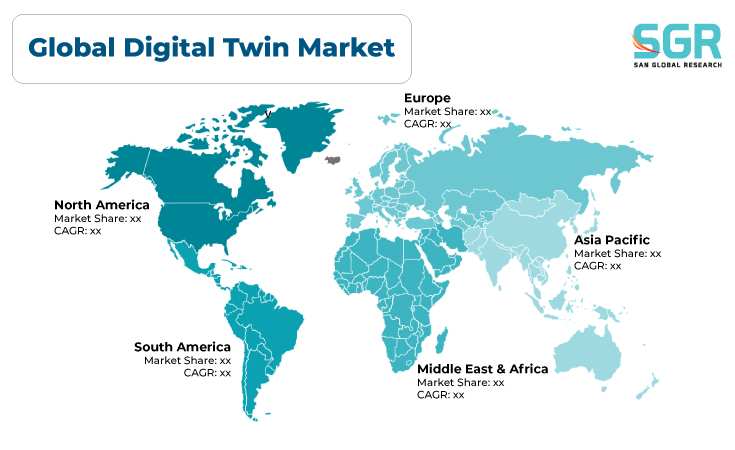
Countries like China, Japan, and South Korea were increasingly recognizing the potential of digital twin technology. Industries in Asia-Pacific, especially manufacturing, automotive, and smart cities, were integrating digital twins for process optimization, predictive maintenance, and urban planning. China's investments in IoT and smart infrastructure projects contributed to the growth of the digital twin market in the region.
Regions like Latin America, the Middle East, and Africa were gradually exploring digital twin applications, albeit at a slower pace compared to other continents. These regions were starting to adopt digital twin technology in sectors such as manufacturing, energy, and infrastructure, focusing on improving operational efficiency and asset management.
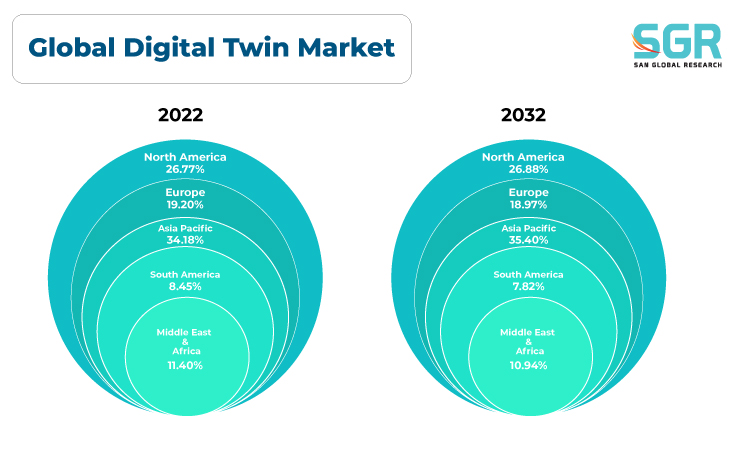
Segmentation:
The Global Digital Twin Market is segmented by solution, by deployment, by enterprise, by application, by end user and region/country.
By Solution:
- Based on the Solution, the Global Digital Twin Market is bifurcated into Component, Process and Systems – where the Component is dominating and ahead in terms of share.The market is primarily comprised of software, services, and IoT (Internet of Things) devices, which collectively drive the functionalities and applications of digital twin technology across industries. Software solutions play a pivotal role, offering the platforms and tools necessary to create, manage, and simulate digital representations of physical assets or systems. These software platforms enable the visualization, analysis, and monitoring of data from digital twins, facilitating real-time insights and predictive analytics. Complementing the software, services such as consulting, implementation, and maintenance support organizations in deploying and maximizing the potential of digital twin technology within their operations.
By Deployment:
- Based on the deployment the Global Digital Twin Market is bifurcated into On Premise & Cloud – where On Premise is dominating and ahead in terms of share.
By Enterprise Size:
- Based on the Enterprise Size, the Global Digital Twin Market is bifurcated into SME & Large – where the SME is dominating and ahead of others in terms of share.
By Application:
- Based on the Application, the Global Digital Twin Market is bifurcated into Product Design & Development, Predictive Maintenance, Business Optimization and Others – where the Product Design & Development is dominating and ahead of others in terms of share.
By End Use:
- Based on the End Use, the Global Digital Twin Market is bifurcated into Manufacturing, Agriculture, Automotive & Transport, Energy & Utilities, Healthcare & Life Sciences, Residential & Commercial, Retail & Consumer Goods, Aerospace, Telecommunication and Others – where the Manufacturing is dominating and ahead of others in terms of share.
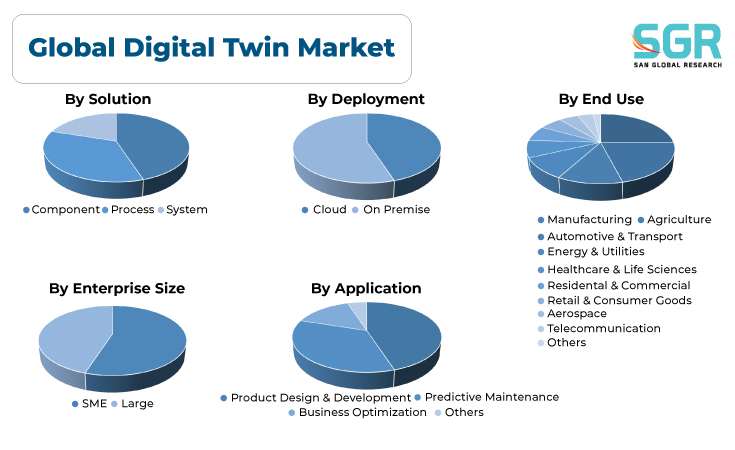
On the basis of region
- North America
- Europe
- Asia Pacific
- South America and
- Middle East and Africa
In 2022, North America is anticipated to dominate the Global Digital Twin Market with market revenue of XX USD Million with a registered CAGR of XX%.
Key Players:
The key market players operating in the Global Computer Aided Engineering Market include
- ABB
- ANSYS
- AUTODESK
- AVEVA
- AWS
- DASSAULT SYSTEMS
- GE
- IBM
- HEXAGON
- MICROSOFT
- SAP SE
- SIEMENS AG
- ROCKWELL
Drivers:
Growing sector across the globe
The global digital twin market is propelled by a convergence of factors that contribute to its rapid expansion and adoption across industries. One of the primary drivers is the increasing need for efficient and predictive solutions in manufacturing, infrastructure, healthcare, and other sectors. Digital twins offer a means to create virtual replicas of physical assets, enabling real-time monitoring, simulation, and analysis, thus enhancing operational efficiency and productivity. Additionally, the proliferation of IoT (Internet of Things) devices and sensors generating vast amounts of data has surged, driving the demand for digital twins to leverage this data for predictive analytics and proactive decision-making. Furthermore, the push toward Industry 4.0 and the adoption of smart technologies in manufacturing and infrastructure development have propelled the integration of digital twins to optimize processes, improve quality, and reduce operational costs. The COVID-19 pandemic also accelerated the adoption of digital twins as organizations sought remote monitoring and management solutions. Moreover, the advancements in AI (Artificial Intelligence) and machine learning algorithms that enhance the capabilities of digital twins for predictive maintenance and anomaly detection have further fueled market growth. As industries increasingly recognize the potential of digital twins to revolutionize operations, enhance resilience, and drive innovation, the global digital twin market continues to surge, propelled by the quest for efficiency, productivity, and data-driven decision-making.
Opportunity:
Evolving Market
The global digital twin market offers a multitude of opportunities across diverse industries, driven by the transformative potential of this technology. One significant opportunity lies in leveraging digital twins to optimize manufacturing processes, enabling predictive maintenance, reducing downtime, and enhancing overall operational efficiency. In the realm of smart infrastructure and cities, digital twins offer prospects for urban planning, traffic management, and efficient resource utilization, contributing to sustainable development and improved citizen services. Additionally, the healthcare sector can benefit from digital twins in personalized medicine, drug development, and healthcare management, allowing for precise simulations and predictive models for better patient outcomes. The integration of digital twins in the automotive industry presents opportunities for enhancing vehicle design, predictive maintenance, and autonomous vehicle development. Furthermore, there are prospects for utilizing digital twins in the energy sector for optimizing resource utilization, predictive maintenance of assets, and efficient grid management. Moreover, advancements in digital twin technology open avenues for new business models, services, and collaborations, fostering innovation and entrepreneurship across industries.
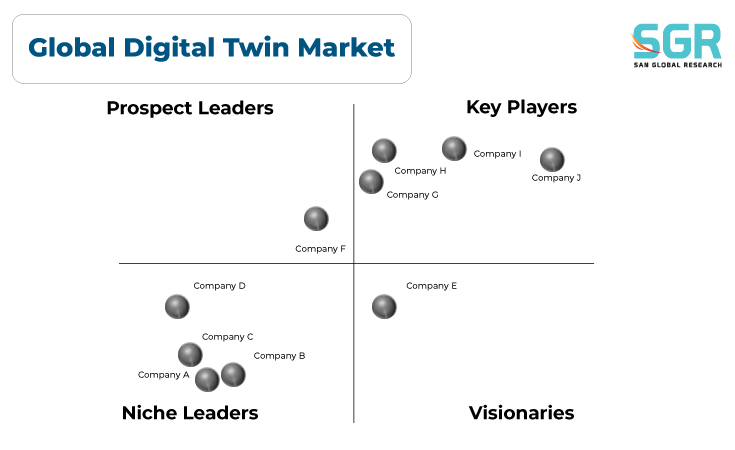

 Description
Description
 Gera Imperium Rise,
Gera Imperium Rise,  +91 9209275355
+91 9209275355


